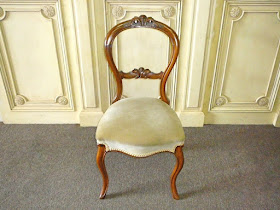When the balloon-backed chair began in the 1830s, however, as illustrated in J.C. Loudon’s Encyclopaedia of Cottage, Farm, and Villa Architecture and Furniture (London, 1833-39), the front legs were straight, although the back ones curved out (below). No stretchers were felt to be necessary. Typical of the Regency style, the turnings of the front legs often incorporated an octagonal section with a bulbous knob at the top.
Seats were upholstered in horsehair and might use a few buttons, which will in. crease in numbers as the Victorian style develops. The term balloon refers to the rounded shoulders of the back with its nipped-in waist and curved crosspiece. In Loudon’s design, the crest or upper rail is characteristic of the first stage due to its dipped effect.
In the second stage in the 1840s, the balloon shape has become more obvious due to the fully rounded crest rail. The increasing importance of curvature is seen on the carved middle rail. The seat shape is also curved in out line and is now heavily buttoned. However, the legs retain the late Regency turnings. A heavily yoked back with a straight cross-rail is sometimes called a “buckle back” by collectors. (middle chair)
By the time of the Great Exhibition of 1851 during the third stage, the curves have taken over. In 1850, American A.J. Downing described this type in his Architecture of Country Houses: "Modern French furniture… in the style of Louis Quatorze.” He says that “its union of lightness, elegance, and grace renders it especially the favourite of ladies….The style of Louis XIV is known by its abundance of light, ornamental scroll- work, and foliage . . . and greater intricacy of detail.”
The Victorians waxed enthusiastically, if inaccurately, about the past. In fact Downing meant the style of Louis XV or Rococo (c1730 - c1760), which featured the cabriole leg. The ‘intricacy of detail’ can be seen in the scrolled and naturalistic carvings on the chair (below left, 1851) with the upholstered panel back, a variant on the balloon-back theme. Its curved seat-apron features the rococo shell in the centre.
These chairs are just as sought after today by Victorian antique collectors, as they were when Downing said, ‘‘at the present moment, [there is] a rage for very light, and fancifully carved chairs for drawing- rooms.”







No comments:
Post a Comment